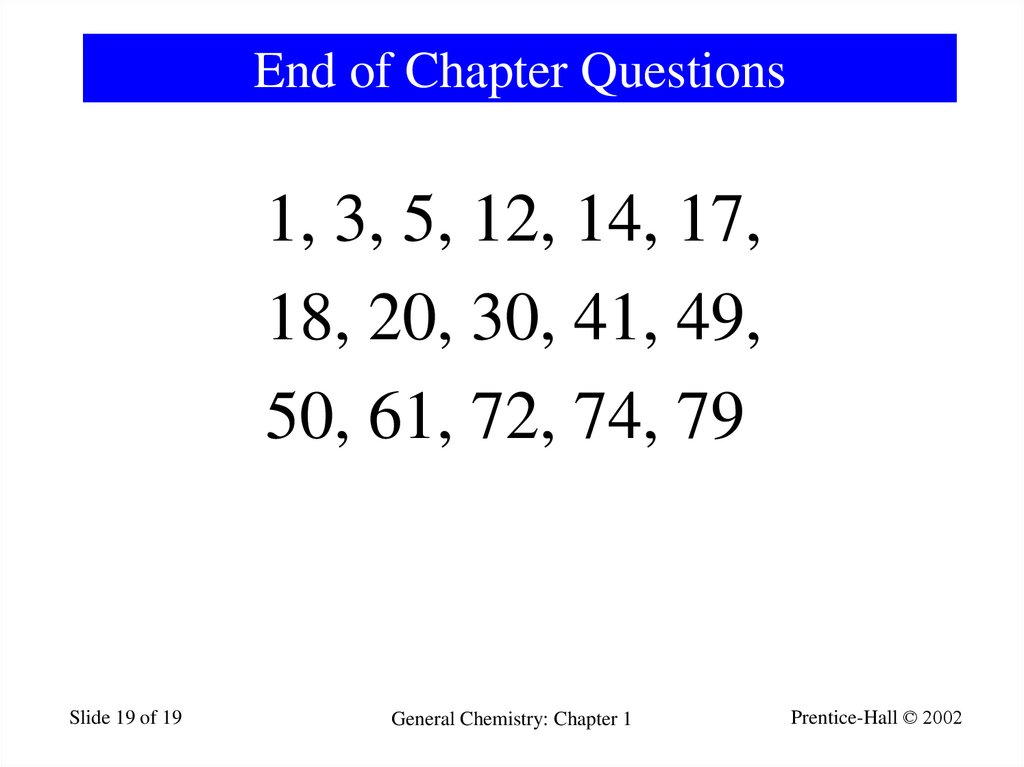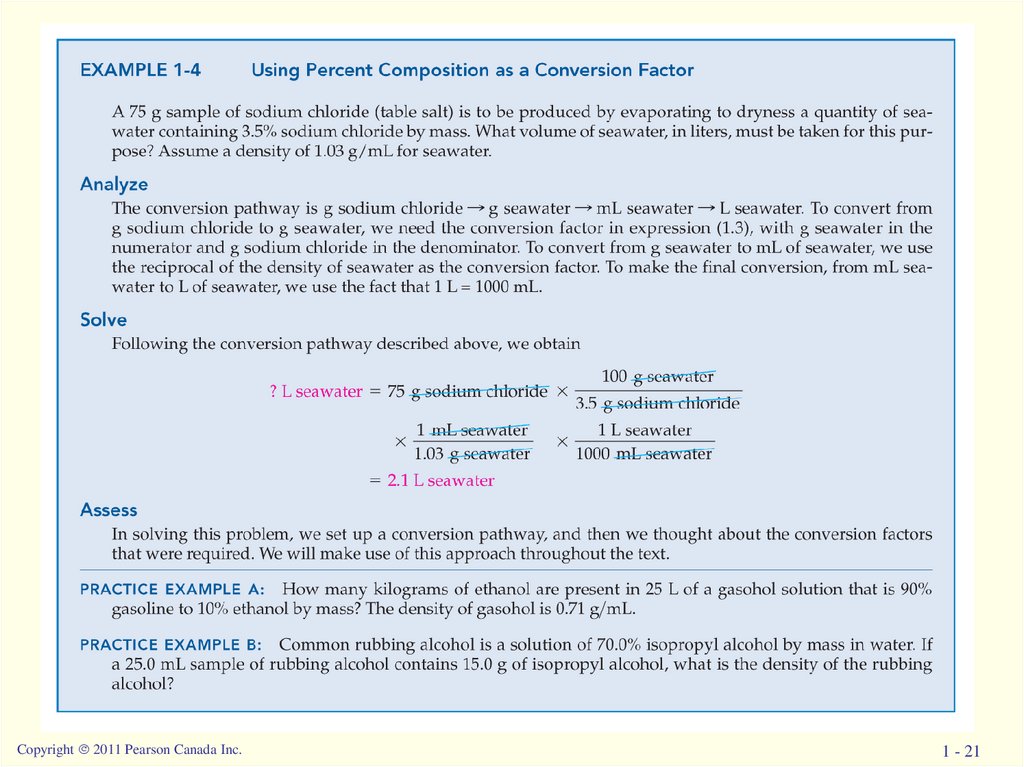Похожие презентации:
General Chemistry
1.
General ChemistryPrinciples and Modern Applications
Petrucci • Harwood • Herring
8th Edition
Chapter 1: Matter—Its Properties and
Measurement
Philip Dutton
University of Windsor, Canada
Prentice-Hall © 2002
Slide 1 of 19
General Chemistry: Chapter 1
Prentice-Hall © 2002
2. Contents
Physical properties and states of matterSystème International Units
Uncertainty and significant figures
Dimensional analysis
http://cwx.prenhall.com/petrucci/chapter1/deluxe.html
Slide 2 of 19
General Chemistry: Chapter 1
Prentice-Hall © 2002
3. Properties of Matter
Matter:Occupies space, properties of mass and inertia
Composition: Parts or components
ex. H2O, 11.9% H and 88.81% O
Properties:
Slide 3 of 19
Distinguishing features
physical and chemical properties
General Chemistry: Chapter 1
Prentice-Hall © 2002
4. States of Matter
Slide 4 of 19General Chemistry: Chapter 1
Prentice-Hall © 2002
5. Classification of Matter
-made up of very tiny units-building block of a different chemical element.
-elements and compouns
-can vary in composition and properties.
-the components separate
into distinc regions.
Slide 5 of 19
General Chemistry: Chapter 1
Prentice-Hall © 2002
6. Separations
-separated into its components by physical means.Slide 6 of 19
General Chemistry: Chapter 1
Prentice-Hall © 2002
7. Separating Mixtures
Chromatography1_17
Substances to
be separated
dissolved in liquid
mixture
Pure
liquid
A
Slide 7 of 19
B
General Chemistry: Chapter 1
C
Prentice-Hall © 2002
8. Significant Figures
Count from left fromfirst non-zero digit.
Number
6.29 g
0.00348 g
9.0
1.0 10-8
100 eggs
100 g
= 3.14159
Slide 8 of 19
Adding and subtracting.
Use the number of decimal
Significant
places in the number with the
Figures
fewest decimal places.
3
3
1.14
2
0.6
2
11.676
infinite
13.416 13.4
bad notation
various
General Chemistry: Chapter 1
Prentice-Hall © 2002
9. Significant figures
Multiplying and dividing.Rounding Off
Use the fewest significant
figures.
3rd digit is increased if
4th digit 5
Report to 3 significant.figures.
0.01208 0.236
= 0.512
= 5.12 10-3
Slide 9 of 19
10.235
12.4590
19.75
15.651
General Chemistry: Chapter 1
10.2
12.5
19.8
15.7
Prentice-Hall © 2002
10. Units
S.I. UnitsOther Common Units
Length
metre, m
Length
Angstrom, Å, 10-8 cm
Mass
Kilogram, kg
Volume
Litre, L, 10-3 m3
Time
second, s
Energy
Calorie, cal, 4.184 J
Temperature Kelvin, K
Pressure
Quantity
Mole, 6.022×1023 mol-1
1 Atm = 1.064 x 102 kPa
1 Atm = 760 mm Hg
Derived Quantities
Force
Newton, kg m s-2
Pressure
Pascal, kg m-1 s-2
Energy
Joule, kg m2 s-2
Slide 10 of 19
-The scientific system of measurement is called
the international system of unit (SI).
-Modern version of metric system
General Chemistry: Chapter 1
Prentice-Hall © 2002
11.
Slide 11 of 19General Chemistry: Chapter 1
Prentice-Hall © 2002
12. Temperature
-most commonly measured in °C-converted to the K
Slide 12 of 19
General Chemistry: Chapter 1
Prentice-Hall © 2002
13. Relative Temperatures
Slide 13 of 19General Chemistry: Chapter 1
Prentice-Hall © 2002
14. Volume
Slide 14 of 19General Chemistry: Chapter 1
Prentice-Hall © 2002
15. Density
= m/Vm=V
V=m/
g/mL
Mass and volume are extensive properties
-dependent on the quentity of matter observed.
Density is an intensive property.
Slide 15 of 19
General Chemistry: Chapter 1
Prentice-Hall © 2002
16. Conversion
What is the mass of a cube of osmium that is 1.25inches on each side?
Have volume, need density
Slide 16 of 19
= 22.48g/cm3
General Chemistry: Chapter 1
Prentice-Hall © 2002
17. Wrong units
The Gimli Glider, Q86, p30Slide 17 of 19
General Chemistry: Chapter 1
Prentice-Hall © 2002
18. Uncertainties
• Systematic errors.– Thermometer constantly 2°C too low.
• Random errors
– Limitation in reading a scale.
• Precision
– Reproducibility of a measurement.
• Accuracy
– How close to the real value.
Slide 18 of 19
General Chemistry: Chapter 1
Prentice-Hall © 2002
19. End of Chapter Questions
1, 3, 5, 12, 14, 17,18, 20, 30, 41, 49,
50, 61, 72, 74, 79
Slide 19 of 19
General Chemistry: Chapter 1
Prentice-Hall © 2002
20.
1 - 20Copyright 2011 Pearson
Canada Inc.
21.
Copyright 2011 Pearson Canada Inc.1 - 21





















 Химия
Химия








